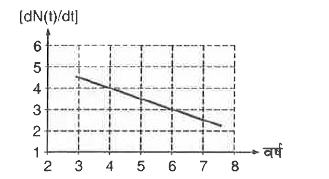For a radioactive meterial , its activity A and rate of charge of its activity R are defined as A=−dNdtandR=−dAdt where N(t) is the number of nuclei at time t .Two radioactive source P (mean life τ ) and Q(mean life 2τ ) have the same activity at t=2τRpandRQ respectively , if RpRQ=ne Solution in Gujrati
The correct Answer is:2
N=N0e−λt
A=λN0e−λt
R=λ2N0e−λt
AP=AQ at t=0
λPNPe−λPt=λQNQe−λQt at t=0
λPNP=λQNQ …(i)
RPRQ=(λPλQ)2(NPNQ)e−λP2τe−λQ2τ
RPRQ=(λPλQ)2(NPNQ)1e ...(ii)
[λP=1mean life]
from equation (i) and equation (ii)
RPRQ=2e
Ans. 2
Topper's Solved these Questions
- SIMPLE HARMONIC MOTIONBOOK - ALLEN CHAPTER - SIMPLE HARMONIC MOTIONEXERCISE - Solved Example
3 Videos
- SIMPLE HARMONIC MOTIONBOOK - ALLEN CHAPTER - SIMPLE HARMONIC MOTIONEXERCISE - X Rays : Solved Example
2 Videos
- SIMPLE HARMONIC MOTIONBOOK - ALLEN CHAPTER - SIMPLE HARMONIC MOTIONEXERCISE - Paragraph
3 Videos
- RACEBOOK - ALLEN CHAPTER - RACEEXERCISE - Basic Maths (Wave Motion & Dopplers Effect) (Stationary waves & doppler effect, beats)
25 Videos
- TEST PAPERBOOK - ALLEN CHAPTER - TEST PAPEREXERCISE - PHYSICS
4 Videos
Similar Questions
A hydrogen like atom with atomic number Z is in an excited state of quantum number 2n. It can emit a maximum energy photon of 204 eV. If it makes a transition ot quantum state n, a photon of energy 40.8 eV is emitted. Find n, Z and the ground state energy (in eV) of this atom. Also calculate the minimum energy (in eV) that can be emitted by this atom during de-excitation. Ground state energy of hydrogen atom is – 13. 6 eV.
View SolutionWhen X-rays if wavelength 0.5Å pass through 10mm thick Al sheet than their intensity is reduced to one sixth . Find the absorption coefficient for Aluminium.
View SolutionA uniform thin cylindrical disk of mass M and radius R is attaached to two identical massless springs of spring constatn k which are fixed to the wall as shown in the figure. The springs are attached to the axle of the disk symmetrically on either side at a distance d from its centre. The axle is massless and both the springs and the axle are in horizontal plane. the unstretched length of each spring is L. The disk is initially at its equilibrium position with its centre of mass (CM) at a distance L from the wall. The disk rolls without slipping with velocity →V0=vacV0ˆi. The coefficinet of friction is μ.

The net external force acting on the disk when its centre of mass is at displacement x with respect to its equilibrium position is.
View SolutionThe frequency of a radar is 780 MHz. After getting reflected from an approaching aeroplane, the apparent frequency is more than the actual frequency by 2.6 kHz. The aeroplane has a speed of
View SolutionChoose the correct statement:
View SolutionFor a radioactive meterial , its activity A and rate of charge of its activity R are defined as A = - (dN)/(dt) and R = (dA)/(dt) where N(t) is the number of nuclei at time I .Two radioactive source P (mean life tau ) and Q(mean life 2 tau ) have the same activity at t = 2 tau R_(p) and R_(Q) respectively , if (R_(p))/(R_(Q)) = (n)/(e)
View SolutionThe activity of a radioactive substance is R0 at t=0, R1 at t=t and R2 at t=2t. The decay constant of this species is/are given by:
View SolutionFor a radioactive material, its activity A and rate of change of its activity of R are defined as A=−dNdt and R=−dAdt, where N(t) is the number of nuclei at time t. Two radioactive source P (mean life τ) and Q (mean life 2τ) have the same activity at t=0. Their rates of activities at t=2τ are Rp and RQ, respectively. If RPRQ=ne, then the value of n is:
View SolutionLet R_(t) represents activity of a sample at an insant and N_(t) represent number of active nuclei in the sample at the instant. T_(1//2) represents the half life. {:(,"Column I",,"Column II"),((A),t=T_(1//2),(p),R_(t)=(R_(0))/(2)),((B),t=(T_(1//2))/(ln2),(q),N_(0)-N_(t)=(N_(0))/(2)),((C),t=(3)/(2)T_(1//2),(r),(R_(t)-R_(0))/(R_(0)) = (1-e)/(e)),(,,(s),N_(t)=(N_(0))/(2sqrt(2))):}
View SolutionIf −(dNdt)o is the initial activity and −(dNdt) is the activity at time t in a radioactive disintegration then :
View SolutionThe relation between half-life T of a radioactive sample and its mean life tau is:
View SolutionTo determine the half life of a radioactive element, a student plots a graph of In ∣∣∣dN(t)dt∣∣∣ versus t. Here dN(t)dt is the rate of radioactive decay at time t.

If the number of radioactive nuclei of this element decreases by a factor of p after 4.16 years. the value of p is...........
View Solutionकिसी रेडियोसक्रिय तत्व की अर्ध - आयु निकालने के लिए एक छात्र ln|dN(t)/dt| का एक t साथ ग्राफ़ बनता है [चित्र] यहाँ dN(t)/dt,t समय पर रेडियोसक्रिय क्षय की दर है। यदि इस तत्व के रेडियोसक्रिय नाभिकों की संख्या , 4.16 वर्षों के बाद p के घटक से कम हो जाती हो , तो p का मान है।

View SolutionActivation A of a radioactive material and R of activation change respectively A=(-dN)/(dt) And R=(-dA)/(dt) The relationship is defined by where N (t) is the number of nuclei at time t. Two radioactive sources P ("औसत आयु" tau) And Q (average age 2tau ) Have the same activation at time t = 0. Their activity change rates time t=2tau Respectively R_(P) And R_(Q) , Is | If (R_(P))/(R_(Q))=(n)/(e) , Then the value of n is
View SolutionFor a radioactive material, is activity A and rate of change of its activity R are defined as A=dNdt and R=dAdt. Two radioactive sources P (mean life τ ) Q (mean life 2τ ) have the same activity at t = 0. Their rates of change of activities at t=2τ are RP and R0 respectively. if RpR0=ne, then the value of n is
View Solution
